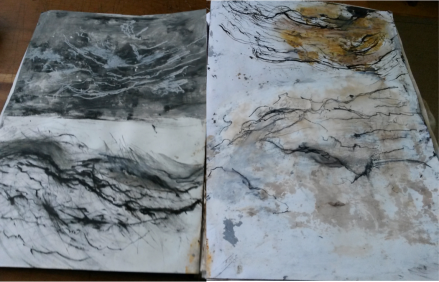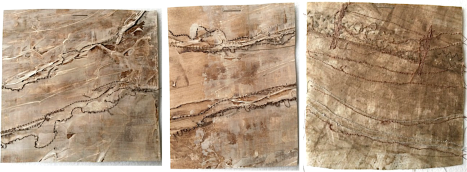With the start of the New Year, it’s a new beginning for me in terms of setting up a blog for the very first time. My aim is to document my learning journey, thought process, developing work and experiences during my final year on the p/t MA in Textiles Course at Manchester Metropolitan University (MMU).
On my MA journey so far, I have explored many avenues, materials, ideas and techniques looking at the dynamics of the sea and its erosion on surfaces and sub surfaces. Initially working with old sailcloth, cotton duck canvas, calico and linen, I have also been working with seaweed as a fabric and more recently become interested in ‘growing’ my own fabric from microorganisms through a process of fermentation.


Where it all began I’ve always had a strong connection and fascination with the sea, growing up near the coast and with a family history involving the Merchant Navy and the fishing fleet. My own experience as a boat owner, Scuba diver and underwater photographer has reinforced this connection and in particular made me very much aware of the significance of tides and currents.
The coastal landscape is constantly changing under the influence of the sea yet apart from seeing the tide going in and out we are almost oblivious to the more subtle changes that take place on a daily basis. Only after time, do we become aware of the accumulation of these changes. I view this in much the same way as biological time transforming our bodies, yet this also goes unnoticed on a daily scale.
I am intrigued by how the sea manages to erode, transform, displace, conceal, reveal and migrate things through the ebb and flow of the tide and its currents. The tide is predictable in that each day it ebbs and flows driven by the sun and the moon, yet it is unpredictable in how it transforms and displaces things, leaving traces, memories and evidence. It’s fascinating how it interacts with the changing wind, weather systems and the contours of the land in a complex way beyond my grasp and thus seems random or accidental. It’s almost as though the high tide pulls a veil over its activities leaving us unaware of the changes it’s making.

I’ve been exploring the subject of coastal erosion and have been carrying out experiments in the estuary of the River Lune, near Lancaster, close to where I live. I learned that Morecambe Bay is renowned for its large tidal range, the second highest in the country at over 10metres. Because of this and the nature of the bay, the channels and banks are highly mobile, capable of slow, steady lateral movements and of sudden sideways shifts of several kilometres. The substrate is ever changing and transforming in appearance. Through my experiments, I was starting to witness erosion and deposition that happens on a geological scale but I was seeing it happen on a daily scale.
Poet Kate Foley in her book Soft Engineering describes this action perfectly as: Ceaselessly licking the coast, the sea is engaged in soft engineering (Foley 1994:27)
I placed parcels and structures in the intertidal zone to observe the impact the tide had on them. I started to gain a better understanding of the sea, its movements and currents within the ebb and flow of the tides.


I documented the changes taking place and became interested in trying to make visible this almost invisible fluctuation and change. I used drawings, stitch, text, photographs, cyanotypes and printmaking (including eco-printing and collagraphs), each time trying to capture the marks and traces left behind by tide and time.



Where next? I am now in the process of developing my experiments, growing my own fabric and looking at how to translate change and transformation over time.
The fabric is called Kombucha and its use originated with the Fashion Designer Suzanne Lee working with a biologist and in 2003 founding an organization called Biocouture (http://www.biocouture.co.uk).
Using tea and a sugar solution with a symbiotic mix of bacteria and yeast (SCOBY), I have been growing ‘Kombucha’ fabric through a process of fermentation. My understanding is that the bacteria form threads and these bond together to create a non-woven mat. This originated as a by-product when producing the Kombucha fermentation drink. Once it is grown (2-4 weeks) washed and dried, the resulting fabric can be as fine and delicate as tissue paper or as thick and flexible as leather.

My research is still very much in its infancy and at the experimental stage as I explore subtle variations in the actual growing process and the effect my interaction has on it. I am also experimenting with the manipulation of the fabric produced. I need to focus my attentions on how this fabric can be used to explore the impact of the tide and the notion of things changing and transforming over time. How surfaces are affected and how traces are left behind.
Thank you for taking the time to read this and I hope you’ll ‘follow’ me on this journey of discovery and learning.
Best wishes, Christine
Great to read about your experiments, and how wonderful to grow your own fabric/substrate
LikeLike
Hi Christine. I love the imagery and the exploration of the tidal erosion on your fabrics. The Kombucha fabric sounds fascinating – look forward to seeing what it you create with it.
LikeLike
Sounds exciting….looking forward to seeing the developments
LikeLiked by 1 person
Well… this is a beautifully clean, straightforward, clear and above all very interesting blog.
Your work seems to explore the relationship between acquired synesthesia and multimedia experiences. As temporal forms become frozen through frantic and personal practice, the viewer is left with an epitaph for the inaccuracies of our culture.
I await to see your story unfold.
LikeLiked by 1 person
Fascinating and inspiring account, great photos too. I’m most interested now in your ‘interaction’ with the kombucha at the growth stages- what happens if ‘foreign bodies’ or textures are introduced and to what extent can variations in and quality of the edge of growth be controlled ? How do you halt growth when that piece of kombucha has achieved the effect you want?
LikeLiked by 1 person
Hi Christine, I love the textures, and surfaces you are getting in your stitched pieces. I am really interested to see where you take the kombucha fabric.
LikeLiked by 2 people
Really interesting Christine, I like the direction you are taking your work – would be interesting to see whether any of you photographs would transfer on to your grown fabric. Lorraine
LikeLiked by 1 person
Really great Christine – it’s really interesting to see the stages of your development and I look forward to seeing the growth of your kombucha!
LikeLiked by 1 person